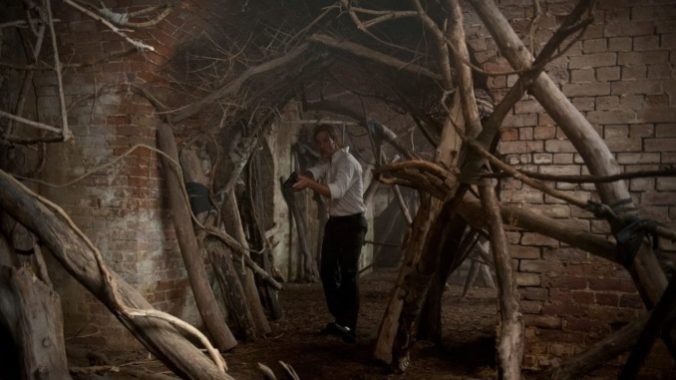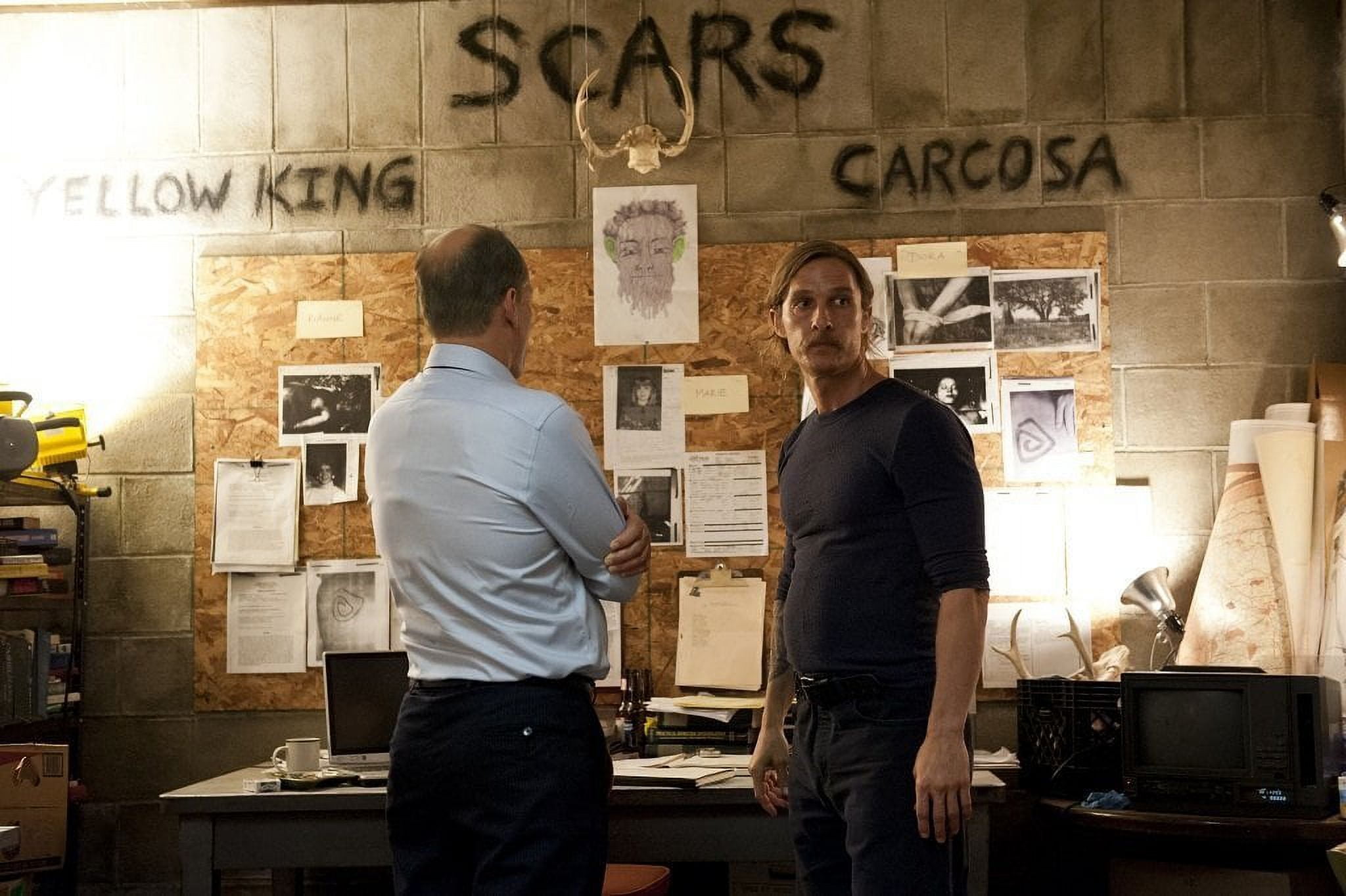
When True Detective debuted roughly 10 years ago, there was a fairly specific idea of what “prestige TV” looked like. While this term has frequently been used to denote quality, it’s far more useful as a way to categorize certain tropes that came into vogue on the small screen over the last two and a half decades: stories about anti-heroes, frequently brooding men, presented with filmic aspirations and heavy dosages of self-seriousness. Although there’s obviously a host of popular and critically acclaimed programs that defied these labels back in the late 2000s and early 2010s (and especially now), the previously defined qualities were very much found in the “important” shows that dominated the conversation at that time, such as Mad Men, Breaking Bad, Boardwalk Empire, and others.
On the surface, the first season of True Detective embodies these characteristics almost to the point of caricature. Following a police investigation into a series of grisly murders, our central cops, Rustin Cohle (Matthew McConaughey) and Martin Hart (Woody Harrelson), feel like the perfect ideal of this era’s protagonist. They’re tortured by their place in the world, trapped by masculinity, and thoroughly miserable. Rust, in particular, has a tendency towards grim monologues that make it clear he’s an abject nihilist. The two are shackled to a decades-old mystery that eats away at them both, with its ritualistic details particularly off-putting and obscene.
But while this heavy tone and focus on tortured men wasn’t novel, the series conveyed this dourness in an undeniably compelling way. From its opening moments, there is a pervading sense of dread captured by Cary Joji Fukunaga’s direction, who helmed every episode of this initial run. This bleak worldview completely subsumes us as we’re trapped with these detectives during stifling rides through rural Louisiana, Rust’s self-indulgent, flowery language tuning us into his intense misanthropy. Although these speeches have been (somewhat fairly) described as overwritten, what makes them work is a combination of McConaughey’s intense performance, along with Marty’s understatedly hilarious exhaustion over his partner’s constant bullshit. (If there’s a genuine mar on these scenes though, it’s that series creator Nic Pizzolatto was accused of plagiarizing from Thomas Ligotti’s non-fiction book The Conspiracy Against the Human Race to create Rust’s monologues.)
This corrosive combination of disquieting imagery and beleaguering ideology made it difficult to look away from the pilot, which had the second-highest ratings for an HBO debut at the time. However, as the story went on, it became clear that its formidable direction and performances would wind up being only part of what made this original season so unforgettable, and the series would eventually introduce elements that weren’t particularly common to the self-serious HBO template: the supernatural. Although the first episode gestured towards strangeness with an occult murder, the second doubles down by directly alluding to a seminal work of weird horror fiction, The King in Yellow.
For those unfamiliar, The King in Yellow is a short story collection by Robert W. Chambers published in 1895. Its most influential tales focus on an in-universe playbook called The King in Yellow, which is banned because those who read it are never the same, frequently becoming obsessed with its verses as they’re driven to disturbing acts. While we only see snippets of this titular text throughout Chambers’ stories, its pages are implied to impart cosmic truths about a mysterious entity known as the King in Yellow, a nefarious being that seems to dwell in a far-off land called Carcosa. Whether this refers to a distant planet, universe, or dimension is unclear, and our only hints lie in the occasional poems left between each yarn.
Chambers’ work has been cited as an inspiration to a host of other creators, such as H.P. Lovecraft, a comparison evident in their shared focus on books that drive people to madness and allusions towards supernatural phenomena that are only explained in passing. Many of these elements are shared across weird horror in general, a subgenre that frequently focuses on occurrences beyond human understanding.

But despite still being masterful works in their own right, Chambers’ short stories are defined by a relative quaintness in our present-day context due to the sheer differences in what was considered scary in a different era. In the years since being published, the specific fears that The King in Yellow interrogates have either been explored extensively in other works or don’t resonate quite as intensely with a contemporary audience as they likely did at the time.
By contrast, True Detective very directly embodies the trends and anxieties of the present. Just as The King in Yellow was preoccupied with issues of its era, such as concerns that unsavory literature could be a “nefarious” influence, this mystery is wrapped up in modern-day phobias cultivated by the small screen. Specifically, decades of police procedurals, cable news, and true crime have created a nagging feeling in the back of many people’s minds that they may be the next victim of some sadistic murderer. George Gerbner, a prominent communications researcher, coined a term for this: mean world syndrome. It’s a theory which states that, as an individual absorbs an increasing amount of media that depicts violent acts, particularly crime, the more likely they are to perceive the world as more violent than it is in reality.
In some moments, it comes across as though Rust directly represents this previously-described inundation with violence, and the walls of his depressing living room are plastered with polaroids of dead bodies and unnerving images of the occult from the case. As with many shows, True Detective is about cops trying to solve a murder, and because it so closely monitors their lives and perspectives, it’s easy to be pulled into their headspace, where killers constantly lurk in the periphery. We follow Rust’s point of view so closely that his jagged worldviews cut through the frame.

While True Detective is only one of countless stories that tap into anxieties about serial murderers, one element that sets it apart is the way it interlaces these commonplace fears with a particular kind of supernatural menace. It can’t be overstated how thoroughly strange it is that we received an HBO police procedural, defined by all the prestige TV hallmarks of its era, that ended up feeling like a new entry in a hundred-year-old weird horror story collection. Although the series’ allusions to The King in Yellow appear to be homages at first, they eventually morph into something more as it becomes unclear if something unnatural is at play. Similar to how Chambers obfuscated the precise logic and credibility of the King in Yellow playbook, the exact truth remains elusive here as well, these ambiguities a persistent buzz heightened by Rust’s philosophical spiels that allude to truths beyond human understanding.
In one scene, as he recounts what happened with the first suspect in the case, Reginald Ledoux, he talks about how our perception of our lives is like a dream, “and like a lot of dreams… there’s a monster at the end of it.” The camera fades to a man in an oxygen mask with a machete, the sinister thrum of the score and offputting freeze-framing hammering home the gravity of these words. While Ledoux isn’t otherworldly in any discernible way, these images and the script come together to create a creeping sense of wrongness, a horrible, bubbling unease that doesn’t fade even after he meets his end. It’s as though this specific combination of words and visuals intermingle the explainable and the unexplainable, the bounds between the two blurred.

One of True Detective’s greatest strokes is that, even through its conclusion, it refused to fully elaborate on every plot point. Just like many classic works of weird fiction, such as The King in Yellow, it doesn’t offer precise explanations about the logic of its potentially unnatural happenings, going as far as refusing to clarify if these events were otherworldy at all. Most pointedly, this ambiguity forces us to contemplate the nature of these abhorrent acts of cruelty.
We’re left wondering whether the precepts of cosmic horror are true, and there are unimaginable nightmares in the stars, or if there are human-made horrors that are just as, if not more, frightening. How could someone do this? And how could the Tuttles be allowed to use their corporate money and political influence to exploit and dehumanize others to this extent, even after their role in all this came to light? In the end, these queries allowed this series, which took the shape of a relatively normal prestige police procedural only to morph into something else, to persist in the mind like an unanswerable question. Because it understands that a horror story where we don’t fully understand the monster is infinitely scarier than one where we do.





